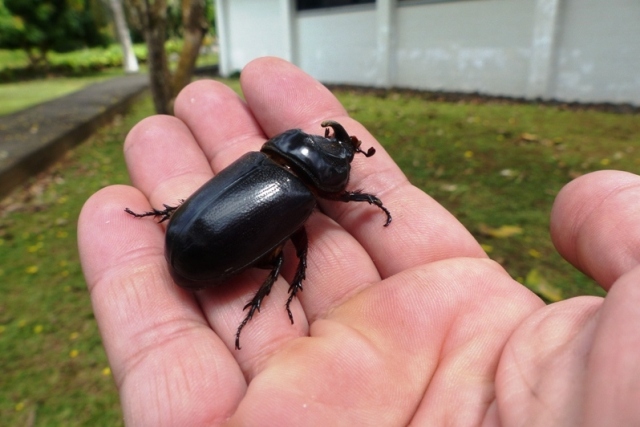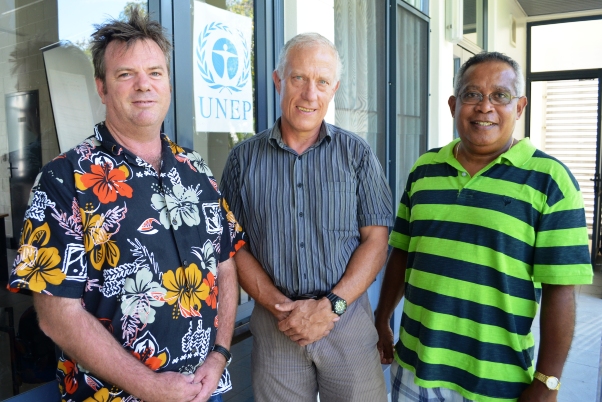
Biodiversity Conservation
Partnerships, hard work, and emerging projects are part of the Invasive Species battle plan for the Pacific islands.
The past month saw the collaboration of the United Nations Environment Programme (UNEP), the Secretariat of the Pacific Regional Environment Programme (SPREP) and the Secretariat of the Pacific Community (SPC) in the newly established UNEP sub-regional office based at SPREP in Apia, Samoa.
The three organisations joined forces to draft the proposed regional project "Prevention, Control and Management of Invasive Alien Species in the Pacific Region" in response to requests by members of SPREP following increasing concern by Pacific Island Leaders over the impact of invasive species in the Pacific islands.
It is anticipated that this project will follow on from a current regional project on "Prevention, Control and Management of Invasive Alien Species in the Pacific Islands", which commenced in 2011 and will end in 2016. One of the common outputs is the development and review of National Invasive Species Strategy and Action Plans.
 The Coconut Rhinoceros Beetle, an invasive alien species found in American Samoa, Fiji, Palau, Papua New Guinea, Samoa, Tokelau, Tonga, Wallis and Futuna and most recently Guam and Hawaii.
The Coconut Rhinoceros Beetle, an invasive alien species found in American Samoa, Fiji, Palau, Papua New Guinea, Samoa, Tokelau, Tonga, Wallis and Futuna and most recently Guam and Hawaii.
Read more about this species in the October issue of the SPREP TOK available now.
"The newly proposed project aims to reduce the threats to the Pacific from invasive species by modeling, testing and assessing the implementation of best practices as components of a comprehensive early detection, control and management framework," said Mr. David Moverley, Invasive Species Adviser of SPREP.
"The project will utilise the "Guidelines for Invasive Species Management in the Pacific", which is the Pacific's own invasive species management framework."
Pacific countries are supporting the project by committing a portion of their GEF STAR Allocation from the GEF 6 Replenishment Fund to implement in-country activities. The Global Environment Facility - System for Transparent Allocation of Resources (GEF-STAR) is one of the largest avenues for funding environment activities.
The Republic of the Marshall Islands, Nauru, Niue and Tonga have so far committed USD4.5million between them which will make the proposed project the largest seen in the Pacific for invasive species once co-financing is included. UNEP, SPREP and SPC are awaiting confirmation from further countries to join the project.

"We're looking forward to the positive outcomes that will come for our Pacific islands region, working together across agencies and across our Pacific islands is a positive step forward in addressing the invasive species battle," said Mr Josua Wainiqolo, Coordinator of Biosecurity and Trade, SPC.
The proposed project will also target GEF6 Global Set Aside Funds to provide regional support for the countries during implementation and to model and compile best practice, operating procedures and tools.
"What is required in the Pacific is a self-sustaining model for regional support for invasive species management and this project is directed towards achieving this" said Dr. Greg Sherley, UNEP Pacific Regional Focal Point and Task Manager.
For more information please contact Mr. David Moverley, SPREP's Invasive Species Adviser at [email protected]
The past month saw the collaboration of the United Nations Environment Programme (UNEP), the Secretariat of the Pacific Regional Environment Programme (SPREP) and the Secretariat of the Pacific Community (SPC) in the newly established UNEP sub-regional office based at SPREP in Apia, Samoa.
The three organisations joined forces to draft the proposed regional project "Prevention, Control and Management of Invasive Alien Species in the Pacific Region" in response to requests by members of SPREP following increasing concern by Pacific Island Leaders over the impact of invasive species in the Pacific islands.
It is anticipated that this project will follow on from a current regional project on "Prevention, Control and Management of Invasive Alien Species in the Pacific Islands", which commenced in 2011 and will end in 2016. One of the common outputs is the development and review of National Invasive Species Strategy and Action Plans.
 The Coconut Rhinoceros Beetle, an invasive alien species found in American Samoa, Fiji, Palau, Papua New Guinea, Samoa, Tokelau, Tonga, Wallis and Futuna and most recently Guam and Hawaii.
The Coconut Rhinoceros Beetle, an invasive alien species found in American Samoa, Fiji, Palau, Papua New Guinea, Samoa, Tokelau, Tonga, Wallis and Futuna and most recently Guam and Hawaii. Read more about this species in the October issue of the SPREP TOK available now.
"The project will utilise the "Guidelines for Invasive Species Management in the Pacific", which is the Pacific's own invasive species management framework."
Pacific countries are supporting the project by committing a portion of their GEF STAR Allocation from the GEF 6 Replenishment Fund to implement in-country activities. The Global Environment Facility - System for Transparent Allocation of Resources (GEF-STAR) is one of the largest avenues for funding environment activities.
The Republic of the Marshall Islands, Nauru, Niue and Tonga have so far committed USD4.5million between them which will make the proposed project the largest seen in the Pacific for invasive species once co-financing is included. UNEP, SPREP and SPC are awaiting confirmation from further countries to join the project.

Joining forces to combat invasive alien species.
L - R Mr. David Moverley SPREP, Dr. Greg Sherley UNEP, Mr. Josua Wainiqolo SPC.
"We're looking forward to the positive outcomes that will come for our Pacific islands region, working together across agencies and across our Pacific islands is a positive step forward in addressing the invasive species battle," said Mr Josua Wainiqolo, Coordinator of Biosecurity and Trade, SPC.
The proposed project will also target GEF6 Global Set Aside Funds to provide regional support for the countries during implementation and to model and compile best practice, operating procedures and tools.
"What is required in the Pacific is a self-sustaining model for regional support for invasive species management and this project is directed towards achieving this" said Dr. Greg Sherley, UNEP Pacific Regional Focal Point and Task Manager.
For more information please contact Mr. David Moverley, SPREP's Invasive Species Adviser at [email protected]